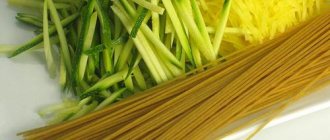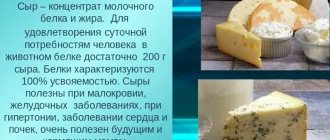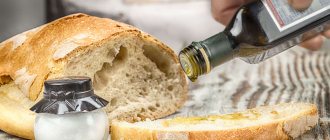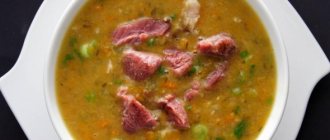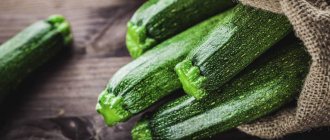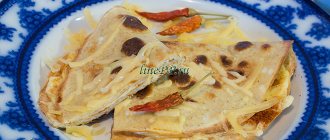There is not always enough time to have a normal lunch, breakfast or dinner. Most often, the stomach and digestive system as a whole suffer from this. In order not to starve and instantly, a variety of sandwiches are ideal for something to snack on. The simplest and most optimal option for breakfast or an ordinary snack is a sandwich with sausage. This dish is quite high in calories and will allow the body to easily wait out the gap between breakfast and lunch without a terrible feeling of hunger. A sandwich is:
- Nourishing;
- Healthy;
- Nutritious;
- Fast.
Calorie content of sandwiches per 100 grams
The standard calculation is based on 100 gram portions of food. Initially, all the nutritional value of the food is indicated in this form due to the optimal size.
The combination of the selected components affects how many calories are in a sausage sandwich:
| Sausage | White bread (230) | Whole grain bread (200) | Rye bread (190) |
| Smoked (510) | 740 | 710 | 700 |
| Liver (330) | 560 | 530 | 520 |
| Salami (560) | 790 | 760 | 650 |
| Cervelat (490) | 720 | 690 | 680 |
- sandwiches and takeaway food
Our list shows how many calories are in sandwiches and takeout items.
You can also search our food database to find calories in over 60,000 foods and calculate the number of calories in your serving. Try for free
Bacon and Egg, Bacon and Tomato, Sausage and Egg, Triple, Tesco*
calories per 100 g sandwich
| calories | 304.0 kcal |
| Carbohydrates | 19.4 g |
| Protein | 9.7 g |
| fat | 20.8 g |
| Fiber | 1.2 g |
Calories per package (256 g): 778 kcal
Chicken, ham and prawn sandwich, trio, Tesco *
calories in 100 g sandwiches
| calories | 142.0 kcal |
| Carbohydrates | 20.2 g |
| Protein | 10.7 g |
| fat | 2.1 g |
| Fiber | 2.2 g |
Calories per package (247 g): 349 kcal
Chicken Fajita Wrap, Boot Shapers*
calories in 100g fajita wrap
| calories | 142.0 kcal |
| Carbohydrates | 21.0 g |
| Protein | 9.0 g |
| fat | 2.2 g |
| Fiber | 1.7 g |
Chicken Fajita Wrap (185g) Calories: 263kcal
Prefer to keep track on paper?
Research has shown time and time again that people who keep a food diary are more successful at losing weight, but not everyone wants to use an online diary, some of us just find it easier to write things down. Here's an easy and very cost-effective way to do it
Chicken Salad Sandwich, Tesco Healthy Living*
calories per 100 g sandwich
| calories | 132.0 kcal |
| Carbohydrates | 16.8 g |
| Protein | 10.7 g |
| fat | 2.5 g |
| Fiber | 4.0g |
Calories per package (195 g): 257 kcal
Egg Mayonnaise Sandwich, Tesco Healthy Living *
calories per 100 g sandwich
| calories | 156.0 kcal |
| Carbohydrates | 21.4 g |
| Protein | 9.3 g |
| fat | 3.7 g |
| Fiber | 2.8 g |
Calories per package: 253 kcal
Tortillas, spicy Mexican dishes, boot shapers*
calories in 100 g of flatbreads
| calories | 153.0 kcal |
| Carbohydrates | 24.0 g |
| Protein | 8.0 g |
| fat | 2.7 g |
| Fiber | 1.9 g |
Calories per package (184 g): 282 kcal
Toasted Ham and Cheese Sandwich, Coffee Republic *
calories per 100 g sandwich
| calories | 268.0 kcal |
| Carbohydrates | 24.4 g |
| Protein | 15.7 g |
| fat | 12.7 g |
| Fiber | 0.0g |
Calories per package (160 g): 429 kcal
Panini with ham and Swiss cheese, Coffee Republic *
Calorie content in 100 g panini
| calories | 250.0 kcal |
| Carbohydrates | 20.5 g |
| Protein | 15.7 g |
| fat | 11.7 g |
| Fiber | 0.0g |
Calorie content of panini (223 g): 557 kcal
Salmon, cucumber and mayo sandwich, deep pour, Tesco *
calories per 100 g sandwich
| calories | 242.0 kcal |
| Carbohydrates | 19.6 g |
| Protein | 13.8 g |
| fat | 12.0g |
| Fiber | 1.8 g |
Calories per package (219 g): 530 kcal
Baguette with tuna and mayonnaise, Pret a Manger *
calories in 100 g baguette
| calories | 232.6 kcal |
| Carbohydrates | 25.0 g |
| Protein | 10.8 g |
| fat | 10.0g |
| Fiber | 1.7 g |
Calories per package (230 g): 535 kcal
Return to top | WEIGHT LOSS | Terms of Use | Privacy Policy
Calories and carbohydrates at your fingertips
- 25,000+ basic and branded products in the UK
- Fully updated for 2021
- New Eating Out section, all major UK restaurants covered
- Products are easy to find
- Information about calories burned
£5 discount here on wlr
Sponsored
.
Number of kilocalories in 1 serving
There are countless recipes for making sandwiches.
Calorie counting allows you to monitor weight gain and loss
Both the serving sizes and their contents differ. Usually this is a cold snack served with tea. But often a hot dish is used in everyday life. The recipe changes the value of the overall product.
Sandwich with harmful calories
How dangerous is a sausage sandwich for our figure? Good question! It is difficult, however, to obtain an exact figure for its calorie content. Again, what kind of sandwich are we talking about? What is the thickness of, for example, bread? After all, even one hundred grams of this most common product contains 240 kcal, and sometimes higher. Now add to all this the nutritional value of sausage. And if some sandwich maniac doesn’t spare the cheese, then, I assure you, the calorie content of such food will immediately jump two or even three times.
Sure
Calorie content of sandwiches on different basis
The most satisfying ingredient is bread. The meat product adds flavor and does not play a big role in preparing the snack.
Despite the great role of flour products, its nutritional value is less than that of any other meat product. Nutritional value is most often reduced due to the base.
Buns made from whole grain wheat, sprouted seeds or rye, buckwheat flour will be more dietary.
Wheat bread
Products made from wheat flour are the most popular in the world.
Be sure to read: French fries: calorie content per 100 grams and BJU of the product from McDonald's, Burger King, KFS
The calorie content of the finished dish is presented in the table:
| Component part | Grammovka | Kcal |
| Wheat flour base | 100 | 242 |
| "Varenka" | 60 | 154.2 |
| Butter | 10 | 74.8 |
That works out to 471 calories per serving.
Loaf, bun
The nutritional value of a slice of flour product is almost always the same.
If there is a loaf or roll among the components, its composition is calculated separately:
| loaf | Kcal per 100 grams |
| Threaded | 264 |
| Podmoskovny | 261 |
| With wheat bran | 273 |
| Metropolitan | 243 |
Buns differ in nutritional value and weight.
The standard recipe for Stolichnaya bun is divided into the following indicators:
| Product | Weight in grams | Nutritional value (kcal) |
| Capital bun | 60 | 162 |
| Semi-smoked Minsk sausage | 40 | 70 |
| Butter | 10 | 74.8 |
| Final indicator | 110 | 306.8 |
Rye bread
Flour products made from rye flour are more dietary than those made from wheat.
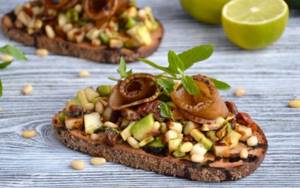
Flour products made from rye flour are more dietary than those made from wheat
A simple sandwich made from this flour has a calorie content of 280 kcal:
| Ingredient | Weight, grams | Nutritional value (kcal) |
| The basis | 52 | 110 |
| Cervelat | 36 | 170 |
| Sum | 88 | 280 |
Grain bread from sprouted seeds
This is the healthiest base of all, since grains activate metabolism. Eating sprouted seeds fills the body with vitamins and minerals (for example, folic acid).
Per 100 grams of flour product there are:
| Calorage | Proteins fats carbohydrates |
| 261 | 45/9/1,5 |
Buckwheat bread
Buckwheat flour contains practically no gluten, so flour products made from it help improve the functioning of the stomach.

Sandwich with buckwheat bread
The nutritional value:
| Calorage | Proteins fats carbohydrates |
| 228 | 30/7/4 |
How many calories and nutritional supplements are in a sandwich with sausage?
The energy value of a dish depends on the type of ingredients.
Calorie content depending on the type of bread
The most high-calorie toasts are on white wheat bread. The BJU of such a snack per 100 grams will be 7/24.1/15.5. Calorie content – 308.
For dietary nutrition, it is better to use black bread. In this case, the calorie content of the entire dish will be significantly reduced: per 100 g it will be only 230 kcal, of which 6 g of proteins, 16 g of fat and 12 g of carbohydrates.
You don't always have a scale at hand, especially when you take toast to work as a snack. The average weight of a piece of loaf and a slice of sausage is 40-50 g. If you add vegetables or sauce, the weight can increase to 100 grams. The average calorie content of a snack is 100-150.
With smoked sausage
It is advisable to check the energy value of smoked products on the label, since the numbers can vary greatly depending on the ingredients in the composition.
But if there is no packaging at hand, the value is calculated independently, based on the type of sausage:
- Cervelat. This is a smoked product made from pork or veal. There are also products made from rabbit or horse meat. 100 g contains no more than 410 kcal. There will be fewer calories in veal cervelat.
- Semi-smoked products. They contain a lot of salt and fat, so they are more nutritious than boiled milk and cervelat. The energy value per 100 g is about 500.
- Raw smoked products. During the production of this product, the meat is not cooked. It is smoked and dried. Due to the high percentage of fat and lack of moisture, raw smoked meat is stored longer than other meat products. 100 grams can contain 560 kcal.
As a snack, it is best to prepare small portions of dietary meat. For example, from veal or turkey.
With boiled sausage
The energy value of popular boiled milk is 250-260 per 100 g. The product contains a lot of fat - 22 grams, as well as protein - 12.2 grams. There are few carbohydrates, no more than 2 grams. The caloric value of one piece is about 60. Together with a slice of loaf, the energy value of the snack will be 138.
Butter is often added to a dumpling sandwich. This makes the snack greasy and unhealthy. At the same time, calorie content increases significantly. 100 g will contain 280 kcal.
With cheese
To calculate the energy value of this snack, you need to know the mass of all the ingredients. A slice of cheese weighs approximately 10 grams. It contains about 30-40 kcal. Toast made from wheat flour will contain about 170 kcal. At the same time, the BJU of the dish per 100 grams will be 13.1/13/29.2.
Calorie content of hot sandwiches
The main component is cheese - it melts and creates a single structure of the dish.
Depending on the recipe, the following portion is formed:
| Compound | Nutritional value (kcal) |
| Piece of rye base (20 g) | 67 |
| Mayonnaise (5 g) | 21 |
| Smoked sausage (20 g) | 60 |
| Russian cheese (10 g) | 36 |
| Per serving | 184 |
Be sure to read: Table of calories, weight and dietary fat in dishes from the KFC restaurant menu per 100 grams or serving
Calorie content, BJU
The calorie content of the dish is relatively high. There are 282.6 kcal per 100 g of product.
The proportions of proteins, fats and carbohydrates are as follows:
- proteins – 15 g;
- fats – 16.4 g;
- carbohydrates – 18 g.
It is not advisable to eat sandwiches all the time. This will lead to swelling, digestive problems, high blood pressure, and weight gain. To reduce the absorption of fats and carbohydrates, it is recommended to add vegetables to the dish, eat a cucumber or vegetable salad after a sandwich.
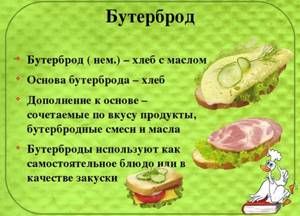
Vegetables contain a large amount of fiber, which prevents fat from being absorbed through the intestinal walls and removes cholesterol and other fat molecules from the body.
How to quickly calculate the calories in a sandwich yourself, calculators and phone applications
A mobile device on any operating system allows you to download an application and count calories in it.
The most popular programs are:
- Yazio. Allows you to record meals throughout the day. Equipped with a barcode scanner for finished products. There are charts for food consumption during the day and weight loss.
- Lifesum. Similar to other services, it includes an automatic counter and has specialized diets.
- FatSecret. It records not only the calories consumed, but also the calories burned.
Even though a sausage sandwich is not the healthiest snack option, it can be modified. Keeping track of kilocalories allows you to change the recipe of a dish.
And mobile apps eliminate the need for mathematical calculations. It is enough to know the weight and name of the ingredient.
A Detailed Guide to Keto for Beginners
We include products that we think will be useful to our readers. If you buy through links on this page, we may earn a small commission. Here's our process.
The ketogenic diet (or keto diet for short) is a low-carb, high-fat diet that provides many health benefits.
In fact, more than 20 studies show that this type of diet can help you lose weight and improve your health (1).
The ketogenic diet may even be beneficial for diabetes, cancer, epilepsy, and Alzheimer's disease (2, 3, 4, 5).
Here's a detailed guide to the keto diet for beginners.
The ketogenic diet is a very low-carb, high-fat diet that has many similarities to the Atkins diet and the low-carb diet.
This involves drastically cutting down on carbohydrates and replacing them with fats. This reduction in carbohydrates puts your body into a metabolic state called ketosis.
When this happens, your body becomes incredibly efficient at burning fat for energy. It also converts fat into ketones in the liver, which can supply energy to the brain (6, 7).
The ketogenic diet can cause a sharp drop in blood sugar and insulin levels. This, along with increased ketone content, has many health benefits (6, 8, 9, 10, 11).
SUMMARY
The keto diet is a low-carb, high-fat diet. It lowers blood sugar and insulin levels and shifts the body's metabolism from carbohydrates to fats and ketones.
There are several versions of the ketogenic diet, including:
- Standard Ketogenic Diet (SKD): This is a diet that is very low in carbohydrates, moderate in protein, and high in fat. It typically contains 75% fat, 20% protein, and only 5% carbohydrates (1).
- Cyclical Ketogenic Diet (CKD): This diet includes periods of high-carbohydrate re-eating, such as 5 ketogenic days followed by 2 high-carb days.
- Targeted Ketogenic Diet (TKD): This diet allows you to add carbohydrates during your workouts.
- High Protein Ketogenic Diet: This is similar to the standard ketogenic diet, but includes more protein. The ratio is often 60% fat, 35% protein and 5% carbohydrates.
However, only the standard and high-protein ketogenic diets have been thoroughly studied. Cyclical or targeted ketogenic diets are more advanced methods and are primarily used by bodybuilders or athletes.
The information in this article primarily applies to the standard ketogenic diet (SKD), although many of the same principles apply to other versions.
SUMMARY
There are several variations of the keto diet. The standard version (SKD) is the most studied and most recommended.
The ketogenic diet is an effective way to lose weight and reduce disease risk factors (8, 9, 10, 11, 12, 13).
In fact, research shows that the ketogenic diet is far superior to the often recommended low-fat diet (2, 14, 15, 16).
What's more, the diet is so filling that you can lose weight without counting calories or tracking your food intake (16).
One study found that people on a ketogenic diet lost 2.2 times more weight than people on a low-calorie, low-fat diet. Triglyceride and HDL cholesterol levels also improved (17).
Another study found that people following a ketogenic diet lost 3 times more weight than people following the diet recommended by Diabetes UK (18).
There are several reasons why the ketogenic diet is superior to a low-fat diet, including increased protein intake, which provides numerous benefits (14, 19, 20).
Increased ketones, decreased blood sugar, and increased insulin sensitivity may also play a key role (21, 22, 23, 24, 25, 26).
To learn more about the effects of the ketogenic diet on weight loss, read this article.
SUMMARY
A ketogenic diet can help you lose weight much more than a low-fat diet. Often this happens without feeling hungry.
Diabetes is characterized by metabolic changes, high blood sugar levels, and impaired insulin function (27).
A ketogenic diet can help you lose excess fat, which is closely linked to type 2 diabetes, prediabetes, and metabolic syndrome (28, 29, 30).
One study found that a ketogenic diet improved insulin sensitivity by as much as 75% (29).
Another study of people with type 2 diabetes found that 7 of 21 participants were able to stop all diabetes medications (28).
In another study, the ketogenic group lost 24.4 pounds (11.1 kg) compared to 15.2 pounds (6.9 kg) in the higher carb group. This is an important advantage when considering the relationship between weight and type 2 diabetes (2, 31).
An additional 95.2% of the ketogenic group were also able to stop or reduce their diabetes medication, compared to 62% in the higher carbohydrate group (2).
For more information, check out this article on the benefits of a low-carb diet for people with diabetes.
SUMMARY
A ketogenic diet can improve insulin sensitivity and induce fat loss, leading to significant health benefits for people with type 2 diabetes or prediabetes.
The ketogenic diet has emerged as a tool for treating neurological diseases such as epilepsy.
Research has shown that the diet may have benefits for a wide variety of health conditions:
- Heart disease: The ketogenic diet may improve risk factors such as body fat, HDL cholesterol, blood pressure, and blood sugar (32, 33).
- Cancer: The diet is currently used to treat several types of cancer and slow tumor growth (4, 34, 35, 36).
- Alzheimer's disease: The keto diet may reduce symptoms of Alzheimer's disease and slow its progression (5, 37, 38).
- Epilepsy: Research has shown that a ketogenic diet can cause a significant reduction in seizures in children with epilepsy (3).
- Parkinson's disease: One study found that diet helped improve symptoms of Parkinson's disease (39).
- Polycystic ovary syndrome: A ketogenic diet may help lower insulin levels, which may play a key role in polycystic ovary syndrome (40).
- Brain injury: One animal study found that diet may reduce concussion and promote recovery from brain injury (41).
However, keep in mind that research in many of these areas is far from conclusive.
SUMMARY
The ketogenic diet can provide many health benefits, especially for metabolic, neurological, or insulin-related diseases.
You should limit your intake of any foods high in carbohydrates.
Here is a list of foods to reduce or eliminate on a ketogenic diet:
- Sweet products: Soda, fruit juice, smoothies, cakes, ice cream, candy, etc.
- Grains or Starches: Wheat-based products, rice, pasta, cereals, etc.
- Fruit: All fruit except small portions of berries such as strawberries.
- Beans or Legumes: Peas, beans, lentils, chickpeas, etc.
- Roots and tubers: Potatoes, sweet potatoes, carrots, parsnips, etc.
- Low-fat or diet foods: These are highly processed and often high in carbohydrates.
- Some condiments or sauces: These often contain sugar and unhealthy fats.
- Unhealthy Fats: Limit your intake of processed vegetable oils, mayonnaise, etc.
- Alcohol: Due to their carbohydrate content, many alcoholic drinks can throw you out of ketosis.
- Sugar-Free Diet Products: These often contain high amounts of sugar alcohols, which in some cases can affect ketone levels. These foods also tend to be highly processed.
SUMMARY
Avoid carbohydrate-based foods such as grains, sugar, legumes, rice, potatoes, candy, juices and even most fruits.
You should base most of your meals on the following foods:
- Meats: Red meat, steak, ham, sausage, bacon, chicken and turkey.
- Oily fish: For example, salmon, trout, tuna and mackerel.
- Eggs: Look for whole, pastured or omega-3 eggs.
- Butter and Cream: Try to feed grass-fed whenever possible.
- Cheese: Unprocessed cheese (cheddar, goat, cream, blue or mozzarella).
- Nuts and Seeds: Almonds, walnuts, flax seeds, pumpkin seeds, chia seeds, etc.
- Healthy oils: Primarily extra virgin olive oil, coconut oil and avocado oil.
- Avocado: Whole avocados or freshly made guacamole.
- Low Carb Vegetables: Most green vegetables, tomatoes, onions, peppers, etc.
- Seasonings: You can use salt, pepper and a variety of healthy herbs and spices.
It's best to base your diet on single-ingredient whole foods. Here's a list of 44 healthy low-carb foods.
SUMMARY
Base the majority of your diet on foods such as meat, fish, eggs, butter, nuts, healthy oils, avocado and plenty of low-carb vegetables.
To help you get started, here is a sample ketogenic diet meal plan for one week:
Monday
- Breakfast: Bacon, eggs and tomatoes.
- Lunch: Chicken salad with olive oil and feta cheese.
- Dinner: Salmon with asparagus, cooked in butter.
Tuesday
- Breakfast: Omelette of eggs, tomatoes, basil and goat cheese.
- Lunch: Almond milk, peanut butter, cocoa powder and a stevia milkshake.
- Dinner: Meatballs, cheddar cheese and vegetables.
Wednesday
- Breakfast: Ketogenic milkshake (try this or this).
- Lunch: Shrimp salad with olive oil and avocado.
- Dinner: Pork chops with Parmesan cheese, broccoli and salad.
Thursday
- Breakfast: Omelet with avocado, salsa, peppers, onions and spices.
- Lunch: Handful of nuts and celery sticks with guacamole and salsa.
- Dinner: Chicken stuffed with pesto and cream cheese, along with vegetables.
Friday
- Breakfast: Sugar-free yogurt with peanut butter, cocoa powder and stevia.
- Lunch: Roast beef in coconut oil with vegetables.
- Dinner: Burger without a bun with bacon, egg and cheese.
Saturday
- Breakfast: Omelet with ham and cheese with vegetables.
- Lunch: Slices of ham and cheese with nuts.
- Dinner: White fish, eggs and spinach cooked in coconut oil.
Sunday
- Breakfast: Scrambled eggs with bacon and mushrooms.
- Lunch: Burger with salsa, cheese and guacamole.
- Dinner: Steak and eggs with side dish.
Always try to alternate between vegetables and meat over time, as each type provides different nutrients and health benefits.
For tons of recipes, check out these 101 Low Carb Recipes.
SUMMARY
There are many delicious and nutritious foods you can eat on a ketogenic diet.
If you're feeling hungry between meals, here are some healthy, keto-approved snacks:
- Fatty meat or fish
- Cheese
- Handful of nuts or seeds
- Cheese with olives
- 1-2 hard boiled eggs
- 90% dark chocolate
- Low Carb Milkshake with Almond Milk, Cocoa Powder and Nut Butter
- Full fat yogurt mixed with nut butter and cocoa powder
- Strawberries and cream
- Celery with salsa and guacamole
- Small portions of leftover dishes
SUMMARY
Great snacks for the keto diet include chunks of meat, cheese, olives, boiled eggs, nuts and dark chocolate.
Many restaurant dishes can be made keto-friendly.
Most restaurants offer meat or fish dishes. Order this and replace any high carb foods with extra vegetables.
Egg-based dishes are also a great option, such as scrambled eggs or eggs and bacon.
Another favorite is bunless burgers. You can also replace fries with vegetables. Add more avocado, cheese, bacon or eggs.
In Mexican restaurants you can taste any meat with the addition of cheese, guacamole, salsa and sour cream.
For dessert, ask for mixed cheese board or creamed berries.
SUMMARY
When eating out, choose a meat, fish or egg based dish. Order extra vegetables instead of carbs or starches and have cheese for dessert.
Although the ketogenic diet is safe for healthy people, there may be some initial side effects as your body adjusts.
This is often called the keto flu and usually goes away within a few days.
Keto flu includes decreased energy and mental performance, increased hunger, trouble sleeping, nausea, digestive discomfort, and decreased physical activity.
To minimize this, you can try a regular low-carb diet for the first few weeks. This can teach your body to burn more fat before you cut out carbs entirely.
The ketogenic diet can also change your body's water and mineral balance, so adding salt to your food or taking a mineral supplement may help.
For minerals, try taking 1,000 mg of potassium and 300 mg of magnesium per day to minimize side effects.
At least in the beginning, it's important to eat until you're full and not restrict too many calories. Typically, a ketogenic diet will result in weight loss without intentionally restricting calories.
SUMMARY
Many side effects from starting a ketogenic diet can be limited. Lightening your diet and taking mineral supplements may help.
Although no supplements are required, some may be helpful.
- MCT Oil: Added to drinks or yogurt, MCT oil provides energy and helps increase ketone levels. Take a look at a few options on Amazon.
- Minerals: Added salt and other minerals may be important at startup due to shifts in water and mineral balance.
- Caffeine: Caffeine is good for energy, weight loss, and productivity.
- Exogenous Ketones: This supplement can help increase ketone levels in the body.
- Creatine: Creatine provides many health and performance benefits. It may help if you combine a ketogenic diet with exercise.
- Whey: Use half a scoop of whey protein in smoothies or yogurt to increase your daily protein intake. You can find many delicious products on Amazon.
SUMMARY
Some supplements may be helpful on a ketogenic diet. These include exogenous ketones, MCT oil and minerals.
Here are answers to some of the most common questions about the ketogenic diet.
1. Can I eat carbs again?
Yes. However, it is important to significantly reduce your carbohydrate intake initially. After the first 2-3 months, you can eat carbohydrates on special occasions - return to the diet immediately.
2. Will I lose muscle?
With any diet, there is a risk of losing muscle mass. However, high protein intake and high ketone levels can help minimize muscle loss, especially if you lift weights.
3. Can I build muscle on a ketogenic diet?
Yes, but it may not work as well as a moderate-carb diet. To learn more about low-carb or keto diets and physical activity, read this article.
4. Is it necessary to refeed or load the carburetor?
No. However, a few high-calorie days every now and then can be beneficial.
5. How much protein can I eat?
Protein should be kept in moderation, as very high intakes can cause insulin levels to spike and ketones to drop. The upper limit is probably around 35% of total calories consumed.
6. What should I do if I am constantly tired, weak or fatigued?
You may not be in full ketosis or using fats and ketones effectively. To counteract this, reduce your carb intake and re-read the points above. Supplements such as MCT oil or ketones may also help.
7. My urine smells fruity. Why is this?
Don't be alarmed. This is simply due to the elimination of byproducts produced during ketosis.
8. My breath smells. What can I do?
This is a common side effect. Try drinking naturally flavored water or chewing sugarless gum.
9. I heard that ketosis is extremely dangerous. Is this true?
People often confuse ketosis with ketoacidosis. The former is natural, while the latter only occurs with uncontrolled diabetes.
Ketoacidosis is dangerous, but ketosis on a ketogenic diet is completely normal and healthy.
10. I have digestive problems and diarrhea. What can I do?
This common side effect usually goes away within 3 to 4 weeks. If the problem persists, try eating more high-fiber vegetables. Magnesium supplements may also help with constipation.
The ketogenic diet is great for overweight people, diabetics, or people looking to improve their metabolic health.
May be less suitable for professional athletes or those looking to gain large amounts of muscle or weight.
Read the article in Spanish
.

